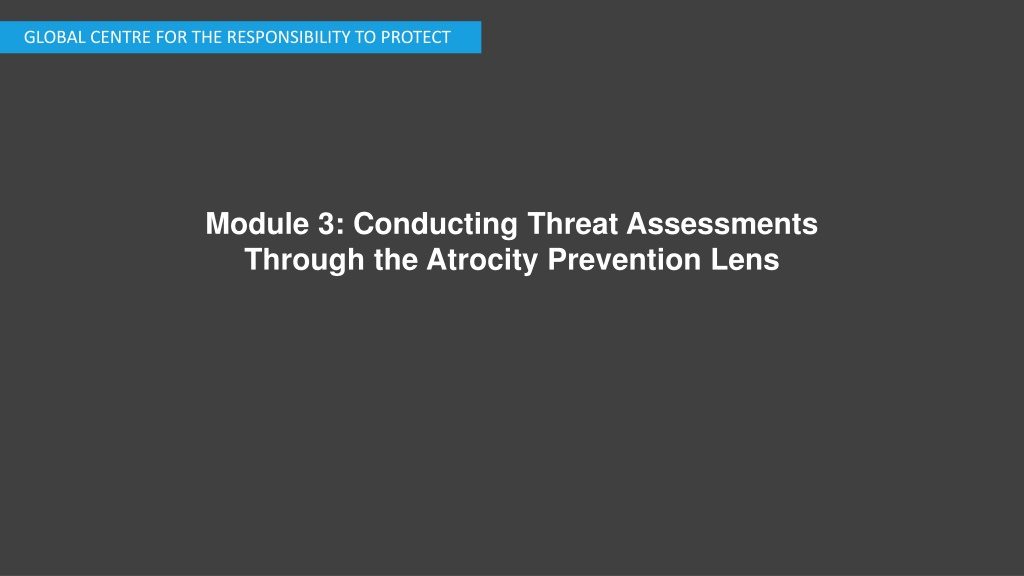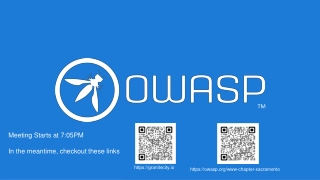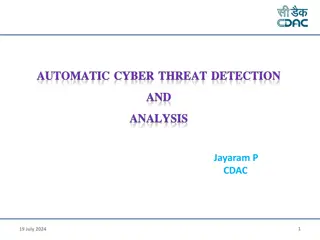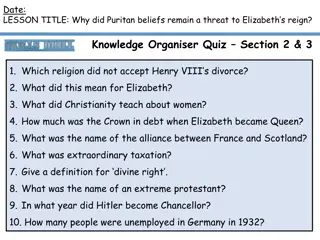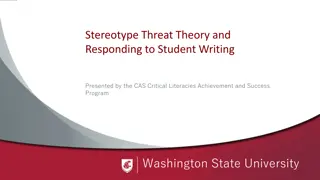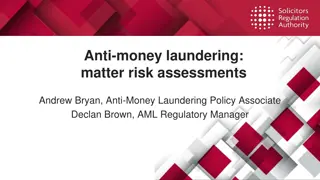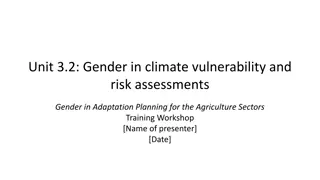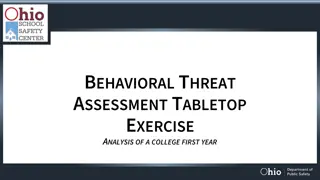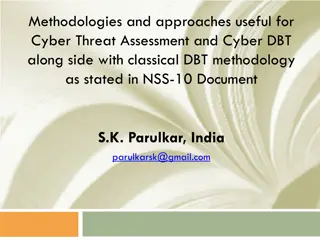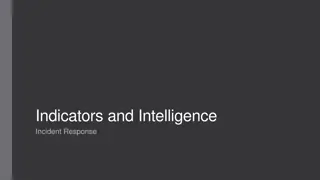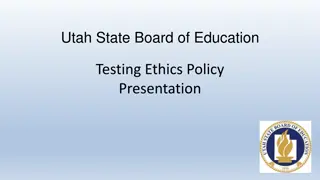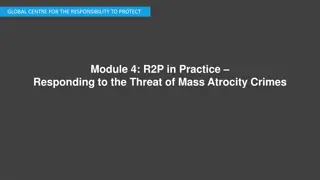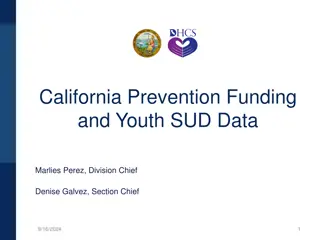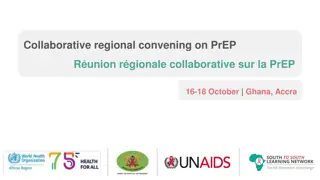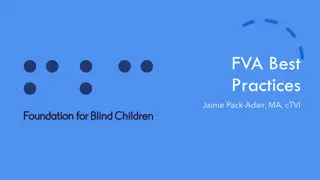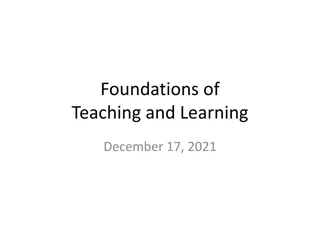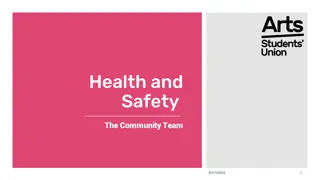Conducting Threat Assessments Through the Atrocity Prevention Lens
This module from the GLOBAL CENTRE FOR THE RESPONSIBILITY TO PROTECT focuses on conducting threat assessments through an atrocity prevention lens. It covers risk identification, situational awareness in field settings, information collection methods, addressing vulnerabilities of women and children, and the importance of designated situational awareness units. Participants learn about conducting threat assessments and monitoring human rights violations to prevent atrocities effectively.
- Threat Assessments
- Atrocity Prevention
- Human Rights Violations
- Womens Protection
- Information Collection
Download Presentation

Please find below an Image/Link to download the presentation.
The content on the website is provided AS IS for your information and personal use only. It may not be sold, licensed, or shared on other websites without obtaining consent from the author. Download presentation by click this link. If you encounter any issues during the download, it is possible that the publisher has removed the file from their server.
E N D
Presentation Transcript
GLOBAL CENTRE FOR THE RESPONSIBILITY TO PROTECT Module 3: Conducting Threat Assessments Through the Atrocity Prevention Lens
GLOBAL CENTRE FOR THE RESPONSIBILITY TO PROTECT Phase 1 Risk Identification Identify Analyze Monitor Treat 1 Module 3: Conducting Threat Assessments Through the Atrocity Prevention Lens
GLOBAL CENTRE FOR THE RESPONSIBILITY TO PROTECT Discussion Question: For those participants that have prior experience in a field setting, how do you carry out situational awareness when on the ground? 2 Module 3: Conducting Threat Assessments Through the Atrocity Prevention Lens
GLOBAL CENTRE FOR THE RESPONSIBILITY TO PROTECT Information Collection in Daily Activities Patrols Establishment of observation posts and checkpoints Monitoring and reporting on human rights violations Outreach and Engagement within area of responsibility 3 Module 3: Conducting Threat Assessments Through the Atrocity Prevention Lens
GLOBAL CENTRE FOR THE RESPONSIBILITY TO PROTECT Addressing the Specific Vulnerabilities of Women and Children Monitoring and Assessment Tasks: Special attention to women and children s protection risks in joint investigations and analysis Liaise with Women Protection Advisers and Children Protection Advisers Specialized Reporting on Conflict-Related Sexual Violence, women and child abductions, recruitment into armed groups, sex trafficking, arbitrary killings that target women/children Ensure female peacekeepers are involved in community engagement activities and establish relationships with women s groups. Ensure women are consulted in threat assessments and use women as resources in monitoring and information gathering activities Establish dial-in radio programs for women to report threats Host radio programs raising awareness of child protection issues Module 3: Conducting Threat Assessments Through the Atrocity Prevention Lens 4
GLOBAL CENTRE FOR THE RESPONSIBILITY TO PROTECT Designated Situational Awareness Units Joint Operations Centres and Joint Mission Analysis Centres Military Intelligence Units Criminal Intelligence Units Geo-spacial Information Systems 5 Module 3: Conducting Threat Assessments Through the Atrocity Prevention Lens
GLOBAL CENTRE FOR THE RESPONSIBILITY TO PROTECT Tools of the Trade: UN Framework of Analysis for Atrocity Crimes Developed by the Office of the UN Special Advisers on Genocide Prevention and the Responsibility to Protect Integrated analysis and assessment tool for addressing atrocity risks Contains 14 risk factors for atrocity crimes and associated indicators of those risk factors 6 Module 3: Conducting Threat Assessments Through the Atrocity Prevention Lens
GLOBAL CENTRE FOR THE RESPONSIBILITY TO PROTECT Common Risk Factors for Mass Atrocity Crimes 1. Situations of armed conflict or other forms of instability 2. Record of serious violations of international human rights and humanitarian law 3. Weakness of state structures 4. Motives or incentives 5. Capacity to commit atrocity crimes 6. Absence of mitigating factors 7. Enabling circumstances or preparatory action 8. Triggering factors 7 Module 3: Conducting Threat Assessments Through the Atrocity Prevention Lens
GLOBAL CENTRE FOR THE RESPONSIBILITY TO PROTECT Specific Risk Factors Genocide: Intergroup tensions or patterns of discrimination against protected groups Signs of an intent to destroy in whole or in part a protected group Crimes Against Humanity: Signs of a widespread or systematic attack against any civilian population Signs of a plan or policy to attack any civilian population War Crimes: Serious threats to those protected under international humanitarian law Serious threats to humanitarian or peacekeeping operations 8 Module 3: Conducting Threat Assessments Through the Atrocity Prevention Lens
GLOBAL CENTRE FOR THE RESPONSIBILITY TO PROTECT Examples of Indicators: Common Risk Factor: Capacity to Commit Atrocity Crimes Availability of personnel and of arms and ammunition, or of the financial resources, public or private, for their procurement. Capacity to transport and deploy personnel and to transport and distribute arms and ammunition. Capacity to encourage or recruit large numbers of supporters from populations or groups, and availability of the means to mobilize them. Strong culture of obedience to authority and group conformity. Presence of or links with other armed forces or with non-State armed groups. Presence of commercial actors or companies that can serve as enablers by providing goods, services, or other forms of practical or technical support that help sustain perpetrators. Financial, political or other support of influential or wealthy national actors. Armed, financial, logistic, training or other support of external actors, including states, international or regional organizations, private companies or others. 9 Module 3: Conducting Threat Assessments Through the Atrocity Prevention Lens
GLOBAL CENTRE FOR THE RESPONSIBILITY TO PROTECT Examples of Indicators: Specific Risk Factor for Genocide: Intergroup Tensions or Patterns of Discrimination against Protected Groups Past or present serious discriminatory, segregational, restrictive or exclusionary practices, policies or legislation against protected groups Denial of the existence of protected groups or of recognition of elements of their identity History of atrocity crimes committed with impunity against protected groups Past or present serious tensions or conflicts between protected groups or with the State, with regards to access to rights and resources, socioeconomic disparities, participation in decision making processes, security, expressions of group identity or to perceptions about the targeted group Past or present serious tensions or conflicts involving other types of groups (political, social, cultural, geographical, etc.) that could develop along national, ethnical, racial or religious lines Lack of national mechanisms or initiatives to deal with identity-based tensions or conflict 10 Module 3: Conducting Threat Assessments Through the Atrocity Prevention Lens
GLOBAL CENTRE FOR THE RESPONSIBILITY TO PROTECT Utilizing the Framework of Analysis Collect reliable information on the situation Use information from the field to inform whether any of the risk factors or respective indicators are present Situate that analysis within the broader political context, assessing whether there are any mitigating factors that could prevent crimes Important to remember: Not all fourteen risk factors need to be present for there to be a significant risk of atrocity crimes occurring The presence of several risk factors does not guarantee that crimes will occur 11 Module 3: Conducting Threat Assessments Through the Atrocity Prevention Lens
GLOBAL CENTRE FOR THE RESPONSIBILITY TO PROTECT Myanmar The Rohingya, a Muslim minority group, have faced institutionalized discrimination in Myanmar for decades. Myanmar's security forces have carried out "clearance operations" in Rakhine State since 25 August 2017 after an armed group calling itself the Arakan Rohingya Salvation Army (ARSA) attacked police posts and an army base. Since that date there have been widespread reports of the security forces imposing collective punishment upon the ethnic Rohingya community, including the unlawful killing of civilians, mass displacement, rape, and the burning of at least 400 villages. At least 720,000 refugees mostly Rohingya have fled across the border to escape violence, bringing the total number of Rohingya refugees in Bangladesh to more than 900,000. Myanmar's authorities seized Rohingya land across Rakhine State. Local government officials have indicated that confiscated land will now be reclassified for other purposes, and that Rohingya refugees will not necessarily be allowed to return to their previous villages. 12 Module 3: Conducting Threat Assessments Through the Atrocity Prevention Lens
GLOBAL CENTRE FOR THE RESPONSIBILITY TO PROTECT Iraq Between October 2016 and July 2017 the Iraqi Security Forces (ISF) conducted a military offensive to recapture the city of Mosul from the so-called Islamic State of Iraq and the Levant (ISIL). A United States-led military coalition lent significant air support to the Iraqi government during the offensive. Throughout the offensive, the UN received credible reports of ISIL forcibly displacing civilians and using civilians as human shields. On 17 March an airstrike on a building in the al-Jadidah district of Mosul, in which ISIL snipers were situated, led to the deaths of up to 200 civilians. The airstrike and civilian deaths were subsequently confirmed by a US military investigation Investigations indicate that the airstrike had triggered explosives placed in the building by ISIL fighters, causing it to collapse. According the US investigation and the ISF, it was unknown that the building had been rigged with explosives. 13 Module 3: Conducting Threat Assessments Through the Atrocity Prevention Lens
GLOBAL CENTRE FOR THE RESPONSIBILITY TO PROTECT Identifying the Threat of Mass Atrocity Crimes Perpetrators Target groups Influential third parties Means for perpetration Potential motives Opportunity for perpetration Early indicators of risk 14 Module 3: Conducting Threat Assessments Through the Atrocity Prevention Lens
GLOBAL CENTRE FOR THE RESPONSIBILITY TO PROTECT Understanding Unique Vulnerabilities of Particular Groups: Depending upon the context of the situation, some populations may be at risk based upon ethnicity, religion, political affiliation, whether they have already been displace and/or other occupational variables. Beyond these differences in communities, certain parts of the population are vulnerable to particular types of attack, including: Gender Age 15 Module 3: Conducting Threat Assessments Through the Atrocity Prevention Lens
GLOBAL CENTRE FOR THE RESPONSIBILITY TO PROTECT MODULE 3 ACTIVITY: THREAT ASSESSMENT 16 Module 3: Conducting Threat Assessments Through the Atrocity Prevention Lens
GLOBAL CENTRE FOR THE RESPONSIBILITY TO PROTECT MODULE 3 ACTIVITY: SYSTEMIC ANALYSIS AND THREAT ASSESSMENT 17 Module 3: Conducting Threat Assessments Through the Atrocity Prevention Lens
GLOBAL CENTRE FOR THE RESPONSIBILITY TO PROTECT Module 3 Learning Outcomes - Review By the end of Module 3, learners will: Understand the ways in which information on risks can be collected and communicated Identify the actors, motives and means that may be present when assessing the threat of mass atrocity crimes Explain how the Atrocity Prevention Lens enhances the ability to assess the potential risks faced by populations Define warning signs and risk factors for mass atrocity crimes 19 Module 3: Conducting Threat Assessments Through the Atrocity Prevention Lens
